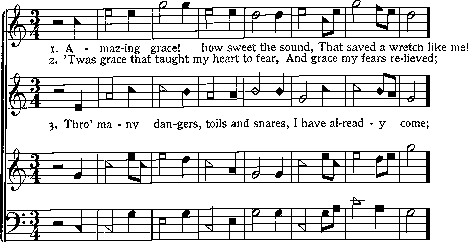
More on the songs...
There is a lot of voice crossing in Sacred Harp music, so the parts are written on individual staves. Below is part of a familiar hymn.
 |
||||||||||||
| Figure from The Sacred Harp, 1991 Revison, p. 45. | ||||||||||||
The top line is NOT the melody! It is a high harmony part called "treble". This part is sung by both men and women in octaves. Treble is for those who are true sopranos or tenors. The second line is alto, just as in standard four-part notation. It is usually sung by women only. The third line from the top is tenor, but it is also called "lead". This is the part that carries the melody, and it is sung by both men and women in octaves. Because this is the melody line, it is often the easiest part for newcomers to sing. The fourth line is bass and is generally sung by men only."
One of the things that contributes to the unique sound of Sacred
Harp is what the singers refer to as "dispersed harmony". Having two of
the four parts sung by both men and women creates a rich six-voice
texture. Also, the parts are written more freely than they would be in
something akin to a Bach chorale. In Sacred Harp, the lines interweave
and overlap each other. They are also much more melodic and interesting
to sing than "traditional" harmony parts. This style of writing,
coupled with the lack of traditional "balance" (melody dominating)
creates a magnificent mass of sound.
There are three types of songs found in The Sacred Harp.
The hymn, or psalm, is a simple homophonic (all voices moving together)
setting. Hymns are generally only a half to full page long.
Sound clip of a Hymn
Fuguing tunes are more complex. They begin with a homophonic section,
and then break into staggered entrances, usually beginning with the
basses. Length-wise they are only slightly longer than hymns, sometimes
as long as two to two and a half pages.
Sound clip of a Fuguing Tune
Anthems are more complex yet. They are the longest works in the
collection, spanning up to six pages. Anthems often employ time
changes, and one even has a key change from minor to the parallel major. The texture varies from
homophonic to polyphonic and some sections are repeated.
Sound clip of an Anthem
Sound clips courtesy of Joshua Martin.